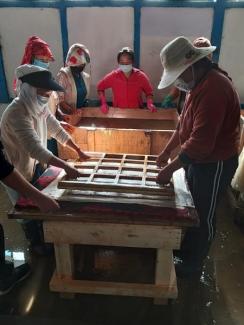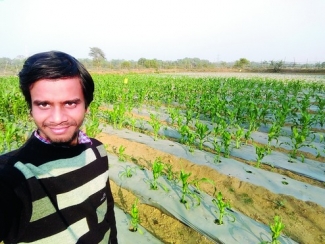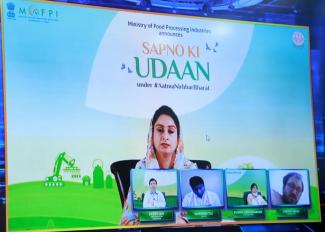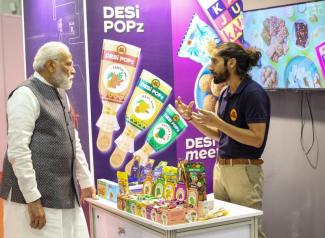
इस समाचार को हिन्दी में पढ़े आगे...
The 1000-year old heritage art – the Monpa Handmade Paper of Arunachal Pradesh – which was driven to extinction, has come to life once again, with the committed efforts of Khadi and Village Industries Commission (KVIC).
The art of making Monpa handmade paper originated over 1000 years ago. Gradually the art became an integral part of local custom and culture in Tawang in Arunachal Pradesh. Once produced in every household in Tawang, this handmade paper was a major source of livelihood for the locals. However, the handmade paper industry almost disappeared in the last 100 years; prompting KVIC to plan revival of this ancient art.
KVIC on Friday commissioned a Monpa handmade paper making unit in Tawang which not only aims at reviving the art but also engaging the local youths with this art professionally and earn. The unit was inaugurated by KVIC Chairman Vinai Kumar Saxena in presence of local people and officials. Inauguration of the paper unit is a historic event for the locals.
The fine-textured handmade paper, which is called Mon Shugu in the local dialect, is integral to the vibrant culture of the local tribes in Tawang. The paper has great historic and religious significance as it is the paper used for writing Buddhist scriptures and hymns in monasteries. The Monpa handmade paper, will be made from the bark of a local tree called Shugu Sheng, which has medicinal values too. Hence availability of raw material will not be a problem.
Back then, such was the scale of production that Monpas used to sell these papers to countries like Tibet, Bhutan,Thailan and Japan as no paper making industry existed in these countries at that time. However, the local industry gradually began declining and the indigenous handmade paper was taken over by inferior Chinese paper.
An attempt for the revival of the this handmade paper industry was made in 1994 but failed as it was a mountainous task owing to various geographical challenges in Tawang. However, with the strong resolve of higher management of KVIC, the unit was successfully established despite many challenges. On the instruction of KVIC Chairman, a team of scientists and officials of Kumarappa National Handmade Paper Institute, (KNHPI) Jaipur, was deputed at Tawang to set up the unit and training the locals. Over six months of rigorous efforts bore fruits and a unit has been commissioned at Tawang.
Initially, the paper unit has engaged 9 artisans who can produce 500 to 600 sheets of Monpa handmade paper per day. The artisans will be earning wages of per day Rs 400 per day. To begin with, 12 women and 2 men from local villages have been trained to make Monpa handmade paper. KNHPI is a unit of KVIC.
The most challenging task for KVIC officials was to transport the machines to Tawang owing to its difficult mountainous terrains and inclement weather conditions. The Arunachal Pradesh Government lent full support to the project and offered a building on a nominal rent to set up the unit.
The KVIC Chairman said reviving the Monpa handmade paper industry and increasing its commercial production was the key objective of KVIC. “Owing to its peculiarity, this handmade paper has high commercial value that can be harnessed to create local employment in Arunachal Pradesh. By increasing production of Monpa handmade paper, it can again be exported to other countries and regain the space occupied by China in the last few decades. This is a local product with great global potential, which is aligned with the Mantra of “Local to Global” given by the Prime Minister,” Saxena said.
Apart from handmade paper, Tawang is known for two other local crafts – handmade pottery and handmade furniture – that are also getting extinct with passage of time. KVIC Chairman announced that within six months plans will be rolled out for revival of these two local arts. “Revival of handmade pottery will be taken up on priority under Kumhar Sashaktikaran Yojana very soon,” Saxena said.
The Monpa handmade paper unit will also serve as a training center for the local youths. KVIC will provide marketing support and explore markets for the locally manufactured handmade paper. KVIC plans to set up more such units in different parts of the country. Saxena said KVIC will also begin production of innovative plastic-mixed handmade paper in Tawang that will be crucial for reducing plastic waste in the region.
परंपरागत कला को पुनर्जीवित करने के लिए केवीआईसी द्वारा तवांग में 1000 वर्ष पुरानी हस्तनिर्मित कागज उद्योग‘मोनपा’ को जिंदा किया गया है
खादी एवं ग्रामोद्योग आयोग (केवीआईसी) के समर्पित प्रयासों के फलस्वरूप 1000 वर्ष पुरानी परंपरागत कला- अरुणाचल प्रदेश का मोनपाहस्तनिर्मित कागज उद्योग- जिसे विलुप्त होने के लिए छोड़ दिया गया था, एक बार फिर जिंदा हो गया है।
मोनपा हस्तनिर्मित कागज निर्माण कला की शुरूआत 1000 वर्ष पूर्व हुई थी औरधीरे-धीरे यह कला अरुणाचल प्रदेश के तवांग में स्थानीय रीति-रिवाजों और संस्कृति का अभिन्न हिस्सा बन गई। एक समय में इस हस्तनिर्मित कागज का उत्पादन तवांग के प्रत्येक घर में होता था औरयह स्थानीय लोगों केलिए उनकी आजीविका का एक प्रमुख स्रोत बन गया था। हालांकि, पिछले 100 वर्षों से यह हस्तनिर्मित कागज उद्योग लगभग गायब हो चुका था; जिसने केवीआईसी को इस प्राचीन कला का पुनरुद्धार करने की योजना बनाने के लिए प्रेरित किया।
केवीआईसी द्वारा शुक्रवार को तवांग में मोनपा हस्तनिर्मित कागज निर्माण ईकाई की शुरूआत की गई, जिसका उद्देश्य न केवल इस कला को पुनर्जीवित करना है बल्कि स्थानीय युवाओं को इस कला के माध्यम से पेशेवर रूप से जोड़ना और उनको धन अर्जित करवाना भी है। इस इकाई का उद्घाटन केवीआईसी के अध्यक्ष, विनय कुमार सक्सेना द्वारा स्थानीय लोगों और अधिकारियों की उपस्थिति में किया गया, जो कि स्थानीय लोगों के लिए एक ऐतिहासिक घटना है।
उत्कृष्ट बनावट वाला यह हस्तनिर्मित कागज, तवांग की स्थानीय जनजातियों के जीवंत संस्कृति का अभिन्न हिस्सा है, जिसे स्थानीय भाषा में मोन शुगु कहा जाता है। इस कागज का एक बहुत बड़ा ऐतिहासिक और धार्मिक महत्व है क्योंकि यह बौद्ध मठों में धर्मग्रंथों और स्तुति गान लिखने के लिए उपयोग किया जाने वाला कागज है। मोनपा हस्तनिर्मित कागज, शुगु शेंग नामक स्थानीय पेड़ की छाल से बनाया जाएगा, जिसकाअपना औषधीय मूल्य भी है। इसलिए इस कागज के लिए कच्चे माल की उपलब्धता की समस्या उत्पन्न नहीं होगी।
पूर्व में,मोनपा का उत्पादन इतने बड़े स्तर पर होता था कि इन कागजों को तिब्बत, भूटान, थाईलैंड और जापान जैसे देशों में बेचा जाता था क्योंकि उस समय इन देशों के पासकागज उत्पादन का कोई उद्योग मौजूद नहीं था।हालांकि, धीरे-धीरे स्थानीय उद्योग में गिरावट दर्ज होनेलगी और स्वदेशी हस्तनिर्मित कागज के स्थान पर निम्नस्तरीय चीनी कागज के अपना कब्जा जमा लिया।
इस हस्तनिर्मित कागज उद्योग का पुनरुद्धार करने का एक प्रयास 1994 में किया गया था, लेकिन वह असफल रहा क्योंकि तवांग की विभिन्न भौगोलिक चुनौतियों के कारण यह एक बहुत ही कठिन कार्य था। हालांकि, केवीआईसी के उच्च प्रबंधन के मजबूत इरादे के कारण, कई चुनौतियां सामने आने के बावजूद इस यूनिट की स्थापना सफलतापूर्वक की गई। केवीआईसी अध्यक्ष के निर्देश पर, तवांग में कुमारप्पा नेशनल हैंडमेड पेपर इंस्टीट्यूट (केएनएचपीआई),जयपुर के वैज्ञानिकों और अधिकारियों की एक टीम को इस यूनिट की स्थापना करने और स्थानीय लोगों को प्रशिक्षित करने के लिए तैनात किया गया था। छह महीने से ज्यादा के कठोर परिश्रम का फल प्राप्त हुआ और तवांग में इसयूनिट की शुरूआत हुई।
शुरुआत में, इस कागज यूनिट में 9 कारीगरों का लगाया गया है, जो प्रतिदिन मोनपा हस्तनिर्मित कागज के 500 से 600 शीट्स का उत्पादन कर सकते हैं। इन कारीगरों को प्रतिदिन 400 रुपये की मजदूरी प्राप्त होगी। शुरुआत में, स्थानीय गांवों की 12 महिलाओं और 2 पुरुषों को मोनपा हस्तनिर्मित कागज बनाने का प्रशिक्षण प्रदान किया गया है। केएनएचपीआई, केवीआईसी की एक इकाई है।
केवीआईसी अधिकारियों के लिए सबसे बड़ा चुनौतीपूर्ण काम तवांग की दुर्गम पहाड़ी इलाकों और खराब मौसम वाली स्थिति में मशीनों को वहां तक लेकर जाना था। अरुणाचल प्रदेश सरकार द्वारा इस परियोजना को पूरा समर्थन प्रदान किया गया और यूनिट स्थापित करने के लिए मामूली किराए पर एक इमारत प्रदान की गई।
केवीआईसी के अध्यक्ष ने कहा कि मोनपा हस्तनिर्मित कागज उद्योग को पुनर्जीवित करना और इसके वाणिज्यिक उत्पादन में वृद्धि करना, केवीआईसी का प्रमुख लक्ष्य था। सक्सेना ने कहा कि, "इसकी विशिष्टता के कारण,इस हस्तनिर्मित कागज का उच्च वाणिज्यिक मूल्य है, जिसका उपयोग अरुणाचल प्रदेश में स्थानीय रोजगार उत्पन्न करने के लिए किया जा सकता है। मोनपा हस्तनिर्मित कागज के उत्पादन को बढ़ावा देकर इसे फिर से दूसरे देशों में निर्यात किया जा सकता है और पिछले कुछ दशकों से चीन द्वारा कब्जा की गई जगह को पुनः प्राप्त किया जा सकता है। यह महान वैश्विक क्षमता वाला एक स्थानीय उत्पाद है, जो कि प्रधानमंत्री द्वारा दिए गए "स्थानीय से वैश्विक" मंत्र के साथ जुड़ा हुआ है।
हस्तनिर्मित कागज के अलावा, तवांग को दो अन्य स्थानीय कलाओं के लिए भी जाना जाता है- हस्तनिर्मित मिट्टी के बर्तन और हस्तनिर्मित फर्नीचर - जो समय के साथ विलुप्त होते जा रहे हैं। केवीआईसी अध्यक्ष ने घोषणा किया कि छह महीने के अंदर इन दोनों स्थानीय कलाओं के पुनरुद्धार के लिए योजनाओं की शुरूआत की जाएंगी। सक्सेना ने कहा कि, "कुम्हार सशक्तिकरण योजना के अंतर्गत प्राथमिकता के आधार पर हस्तनिर्मित मिट्टी के बर्तनों का पुनरुद्धार बहुत जल्द ही शुरू किया जाएगा।"
मोनपा हस्तनिर्मित कागज यूनिट, स्थानीय युवाओं के लिए एक प्रशिक्षण केंद्र के रूप में भी कार्य करेगी। केवीआईसी केवल इसको विपणन सहायता प्रदान करेगा बल्कि स्थानीय रूप से निर्मित हस्तनिर्मित कागज के लिए बाजार की भी तलाश करेगा। केवीआईसी की योजना देश के विभिन्न इलाकों में इस प्रकार की अन्य इकाइयों की स्थापना करने की है। सक्सेना ने कहा कि केवीआईसी द्वारा तवांग में अभिनव प्लास्टिक मिश्रित हस्तनिर्मित कागज का उत्पादन भी शुरू किया जाएगा, जो कि इस क्षेत्र में प्लास्टिक कचरे में कमी लाने की दिशा में एक महत्वपूर्ण कदम साबित होगा।











